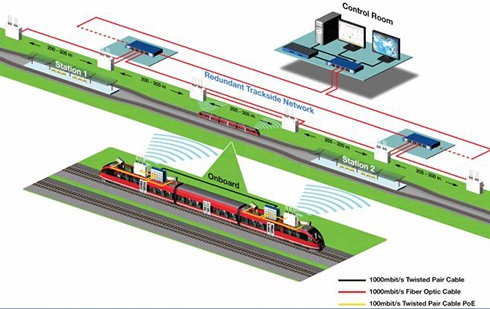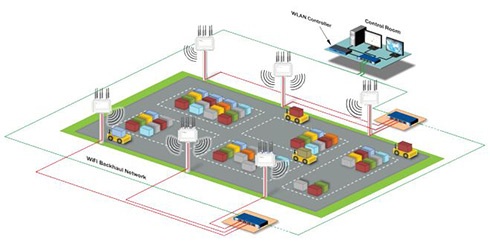How Does Fast Roaming Improve Industrial Wi-Fi?
What do pre-programmed robots on a factory floor have in common with driver-less trains and metro systems? A uniquely advanced degree of automation. Automation is transforming lives at an unprecedented rate. In the railway industry, for example, technological innovation is taking the shape of futuristic offerings, like driver-less cars and trains. And now these same innovations are coming to other transportation applications and the factory floor.
System operators depend on strong, reliable wireless connections to efficiently operate the network that supports these developments and keep passengers and employees safe. Interruptions to communication due to slow or unreliable roaming in these mission-critical situations puts any company at risk of financial and reputational damage.
Fast roaming significantly reduces these risks. With its long communication ranges and high transmission speeds, the technology allows mobile clients to roam continuously throughout a wireless network, seamlessly sending packets of information between control bases, access points and end devices. This permits continuous connectivity onboard trains and other vehicles that rely on wireless communication to operate. Without fast roaming, the mobility, reliability and security required by industrial systems, especially those that operate autonomously, would not be possible.

Railway networks use fast roaming technologies to boost industrial Wi-Fi performance, guaranteeing end-to-end packet delivery and arrival.
Fast Roaming Enables Wireless Connectivity
The use of wireless to expand communication throughout factory and transportation networks provides teams with simple implementation processes and reduced application costs, in addition to:
- Continuous connectivity: Industrial applications cannot safely operate without round-the-clock communication between the control room, mobile clients and wireless access points. A particularly interesting example to note is communication within railway networks. Reliable communication is required between the train, control room, the tracks and even the rail cars. No matter how fast a train is travelling, for instance, or where it is located, disruptions to wireless connectivity pose potentially harmful risks to operators, passengers and the train itself. If a rail car does not receive a packet in time, communication may be delayed and a control room might not have the critical information it needs to tell a car to adjust its speed so as not to hit another car ahead on the tracks, though other safety measures would be in place. Fast roaming offers railway networks higher throughput rates with minimal packet loss ratios. What this tells us is that increased roaming speeds extend network reach further, nearly guaranteeing the delivery of every packet (throughput) without any disruptions between the sending and receiving devices.
- Strong security controls: Across all industrial applications, wireless communication beckons for strong security measures. Just like mailing a letter without a sealed envelope increases the likelihood of the note getting stolen and personal information being exposed, packets traveling through networks without high security standards are susceptible to technical vulnerabilities and information leaks. The IEEE 802.11i standard defines how a wireless connection can be secured via established network guidelines. With a well-protected, fast roaming industrial Wi-Fi network, packets can safely travel over extended communication ranges with no latency.
- Amplified reliability standards: Factory floors that were once manned by human-driven workplace vehicles have turned toward a future driven by robots, consisting of automated guide vehicles (AGVs). These vehicles are specialized transportation units that rely on high-reliability standards and fast roaming speeds to communicate via mounted access points and control and client sensors throughout the factory floor. As autonomous vehicles, AGVs depend on a strong and reliable network for uninterrupted communication, risking a halt in operation should an information packet be disrupted or go undelivered. To ensure the highest degree of reliability is achieved, a network must have sufficient coverage so a mobile client can switch from one access point to another as quickly as possible.

Fast roaming enhances AGV communication by extending transmission ranges across multiple access points.
Technologies for Successful Fast Roaming
To optimize the capabilities of industrial Wi-Fi networks, there are a couple of technologies employed that typically lead to higher roaming speeds, while continuing to maintain thorough network security. A solution providing only one or the other would not be sufficient.
1. Fast roaming with highest Wi-Fi security: Mobile clients move through the transmission range of several different access points, which means the reliability of the communication and available bandwidth must be guaranteed at all times. Fast roaming works to optimize communication and bandwidth by automatically allowing clients to connect to access points with the greatest signal, frequently achieving interruptions of less than 50 ms. When a mobile client is in motion and wants to change its current connection to a different access point, the client triggers a procedure to enact a fast Basic Service Set (BSS) transition as defined in the IEEE 802.11 standard. A secure transition can only take place when a client connects to and authenticates the target access point by providing a valid key for encrypted data packets. To consistently safeguard and ensure fast roaming, a network might also adopt any of the four following techniques: Pre-Master Key (PMK) Caching, Pre-Authentication, Opportunistic Key Caching (OKC) and the IEEE 802.11r standard. These techniques are applied to fast roaming technology to optimize network roaming while continuing to deliver consistent security.
2. Fast roaming through reduced scan times: When a railway operator wants to know whether a track is available at an upcoming station, he or she typically sends a flicker or alarm to find out if the space is already occupied or not. A train sending wireless signals would also follow the same procedure to scan a channel or frequency to identify if an upcoming trackside access point is busy or not, looking to avoid packet interruptions at all costs. The active method to locate available frequencies of available access points is through repetitive, quick channel scans of wireless local area networks (WLANs). If an access point responds to a train’s “Who’s there?” query with “Me!”, the client can actively and efficiently make note of potential roaming target points and their surrounding company.
If channels that require radar detection are also used, such as in outdoor operation within 5 GHz, this poses a further challenge. For these channels, clients are not allowed to actively search for access points by sending probe requests (“Who’s there?”), but they must first determine if the channel has a primary user, such as a radar station. Since this determination must be repeated and requires one minute of passive listening, this is not an option for fast roaming outdoors. Therefore, the client is obliged to sequentially listen to all existing channels until the access points make themselves known. With access points and clients specially optimized for fast roaming, the timings of periodic announcements and waiting times are configurable. Thus, very fast roaming can be facilitated, especially in outdoor operation in the less congested 5 GHz band.
Though created to work in sync, the technologies above should be considered as methods to optimize industrial Wi-Fi, not in place of standard network security measures. Incorporating these technologies ensures throughput requirements are met and increases reliability and communication range while reducing packet latency and interruption. All of these benefits result in a seamless handover of information between end devices, giving railway operators and passengers constant and trustworthy connectivity.
Fast Roaming Is Here – If You Don’t Have It, Get It
Fast roaming is undoubtedly critical to the success of industrial transportation and manufacturing applications. As automation continues to transform industrial equipment and settings, fast roaming will grow in navigational and operational importance.
Teams need to consider how this technology will reduce financial, reputational and safety risks and bring their networks forward. With fast roaming capabilities, teams will have the know-how to set their industrial Wi-Fi networks up for success today and in the future.
Interested in reading more on the topic? This Belden white paper outlines which fast roaming technologies can ensure your network requirements are consistently met: IEEE 802.11 – Technologies for Fast Roaming.
![System.String[]](https://assets.belden.com/transform/cffa44ff-6ef3-46d7-a5db-8259fe3295b9/Wiegel?io=transform:fill,width:300,height:300)